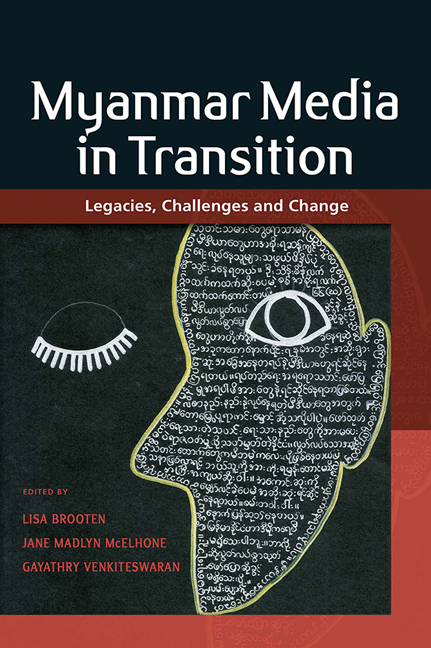Book contents
- Frontmatter
- Contents
- Contributors and Editors
- Burma or Myanmar? A Note on Terminology
- 1 Introduction: Myanmar Media Historically and the Challenges of Transition
- Part I Structural Constraints and Opportunities
- Part II Journalism in Transition
- 6 Silencing a Snakehead Fish: A Case Study in Local Media, Rural-Based Activism, and Defamation Litigation in outhern Myanmar
- 7 Precarity and Risk in Myanmar's Media: A Longitudinal Analysis of Natural Disaster Coverage by The Irrawaddy
- 8 Educating a New Generation of Watchdogs: Interview with Ye Naing Moe, Director of the Yangon and Mandalay Journalism Schools
- 9 The Metamorphosis of Media in Myanmar's Ethnic States
- 10 Covering Rakhine: Journalism, Conflict and Identity
- 11 Media in Myanmar: Laws, Military and the Public
- 12 Cracking The Glass Ceiling in Myanmar Media
- 13 Media and the 2015 General Elections
- Part III Creative Expression
- Part IV Society and Media
- Epilogue: Media Studies in Myanmar – Where Do We Go from Here?
- Index
7 - Precarity and Risk in Myanmar's Media: A Longitudinal Analysis of Natural Disaster Coverage by The Irrawaddy
from Part II - Journalism in Transition
Published online by Cambridge University Press: 07 September 2019
- Frontmatter
- Contents
- Contributors and Editors
- Burma or Myanmar? A Note on Terminology
- 1 Introduction: Myanmar Media Historically and the Challenges of Transition
- Part I Structural Constraints and Opportunities
- Part II Journalism in Transition
- 6 Silencing a Snakehead Fish: A Case Study in Local Media, Rural-Based Activism, and Defamation Litigation in outhern Myanmar
- 7 Precarity and Risk in Myanmar's Media: A Longitudinal Analysis of Natural Disaster Coverage by The Irrawaddy
- 8 Educating a New Generation of Watchdogs: Interview with Ye Naing Moe, Director of the Yangon and Mandalay Journalism Schools
- 9 The Metamorphosis of Media in Myanmar's Ethnic States
- 10 Covering Rakhine: Journalism, Conflict and Identity
- 11 Media in Myanmar: Laws, Military and the Public
- 12 Cracking The Glass Ceiling in Myanmar Media
- 13 Media and the 2015 General Elections
- Part III Creative Expression
- Part IV Society and Media
- Epilogue: Media Studies in Myanmar – Where Do We Go from Here?
- Index
Summary
In the mid-2000s, journalists from Burma working in exile in neighbouring countries faced constant safety challenges, be it intimidation from local police or surveillance by the Burmese military intelligence. In 2017, journalists from these same publications, now back in the country, faced new challenges: intimidation by government officials and arrests within the country. Given the uneven pace and patterns of change in Myanmar (see the introductory chapter to this volume) and the importance of media in covering these developments, it is useful to investigate how collecting and reporting news about Myanmar have evolved in line with the promises of that change.
In this chapter we use the twin concepts of precarity and mobilization to explore the tensions associated with media reporting about Myanmar over time, analysing the reporting of the (formerly) exiled media publication The Irrawaddy. The chapter explores coverage through an examination of the sources utilized and the substantive content and tone of the articles. We begin by reviewing The Irrawaddy's history and then position it through the lenses of mobility and precarity. After a discussion of methods, we compare the coverage in The Irrawaddy of three natural disasters, in both the English and Burmese editions, and supplement our analysis with interviews with members of staff. Our findings indicate that risks associated with reporting have lessened considerably, but tension remains as The Irrawaddy is hamstrung by conflicting goals that influence its coverage.
The Irrawaddy: Outside-In
The story of Myanmar's incomplete reforms would itself be incomplete without a discussion of The Irrawaddy, whose role as a publisher, in turn, of a monthly magazine, weekly print journal, video content, and now digital media has secured its place in the country's media history. Founded in exile in 1993 by Aung Zaw and other exiled journalists, The Irrawaddy went from an “amateurish, four-page newsletter” (Cochrane 2006, p. 87) to a website that reaches millions. Operating as exiled media from Thailand for its first two decades, The Irrawaddy's position — simultaneously out-of-reach from Myanmar's restrictive government but proximate to events in Myanmar at a time, prior to the internet, when information was not as easy to share across restrictive borders — allowed it to offer credible counter-narratives to official government sources. Its readership has included people both inside and outside the country, both English and Burmese speakers, and both military and opposition leaders (the latter while in prison), as well as other stakeholders.
- Type
- Chapter
- Information
- Myanmar Media in TransitionLegacies, Challenges and Change, pp. 177 - 200Publisher: ISEAS–Yusof Ishak InstitutePrint publication year: 2019

